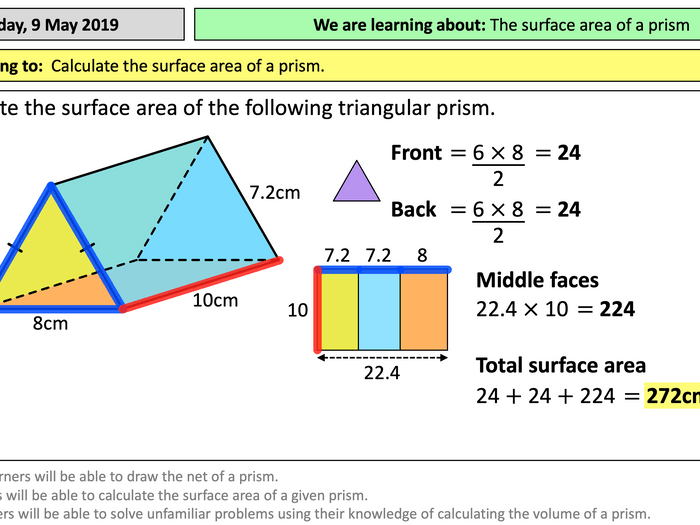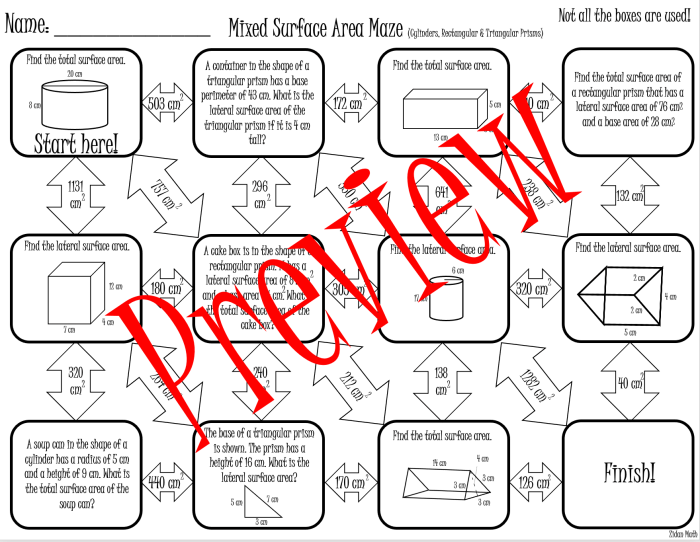Surface area of prisms maze answer key – Welcome to the realm of geometry, where the surface area of prisms takes center stage. Embark on an intriguing journey through a surface area maze puzzle answer key, a labyrinth of concepts and calculations that will illuminate the intricacies of this mathematical enigma.
This comprehensive guide will equip you with the knowledge and techniques to navigate the complexities of prism surface area calculations, empowering you to solve challenging puzzles and unlock the secrets of spatial relationships.
Surface Area of Prisms: Basic Concepts

Surface area of a prism is the total area of all its faces. For different types of prisms, the formulas for calculating surface area vary.
For a rectangular prism, the surface area (SA) is given by:
- SA = 2(lw + lh + hw)
where l, w, and h are the length, width, and height of the prism, respectively.
For a triangular prism, the surface area is given by:
- SA = 2(bh + ph + ph)
where b is the base length, h is the height of the triangle, and p is the length of the lateral edge.
For a hexagonal prism, the surface area is given by:
- SA = 2(6bh + ph)
where b is the base length, h is the height of the prism, and p is the length of the lateral edge.
Maze Puzzle: Solving for Surface Area
A surface area maze puzzle is a type of maze where the goal is to find a path from the start to the end while maximizing the total surface area of the prisms encountered along the path.
To solve the puzzle, one needs to:
- Understand the surface area formulas for different types of prisms.
- Identify the dimensions of the prisms in the maze.
- Choose the path that results in the greatest total surface area.
Example:
In a maze with rectangular prisms, a path that encounters three prisms with dimensions 2x3x4, 3x4x5, and 4x5x6 will have a total surface area of 2(2×3+3×4+4×2) + 2(3×4+4×5+5×3) + 2(4×5+5×6+6×4) = 208 square units.
Prism Properties and Surface Area Calculations, Surface area of prisms maze answer key
The properties of prisms that affect their surface area include:
- Number of faces
- Shape of faces
- Dimensions of faces
To calculate the surface area of a prism, one can follow these steps:
- Identify the type of prism.
- Determine the dimensions of the faces.
- Use the appropriate surface area formula.
Example:
To calculate the surface area of a rectangular prism with length 5 cm, width 3 cm, and height 4 cm:
- SA = 2(5×3+3×4+4×5) = 110 cm 2
Applications of Surface Area Calculations
Surface area calculations have practical applications in various fields, including:
- Architecture:Calculating the surface area of buildings to determine the amount of paint or siding needed.
- Packaging:Optimizing the surface area of packaging materials to minimize waste and maximize efficiency.
- Engineering:Determining the surface area of heat exchangers to calculate heat transfer rates.
It’s important to note that surface area calculations may have limitations, such as not accounting for the thickness of materials or the presence of openings.
FAQ Insights: Surface Area Of Prisms Maze Answer Key
What is the surface area of a prism?
The surface area of a prism is the total area of all its faces.
How do I calculate the surface area of a rectangular prism?
To calculate the surface area of a rectangular prism, multiply the length by the width and then add the product of the length by the height and the width by the height.
What is a surface area maze puzzle?
A surface area maze puzzle is a puzzle where you must find a path from the starting point to the ending point while minimizing the total surface area of the path.

